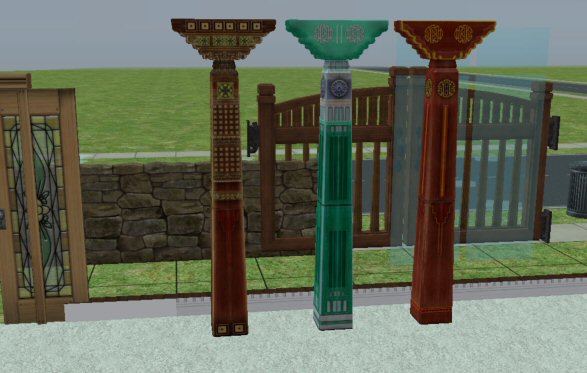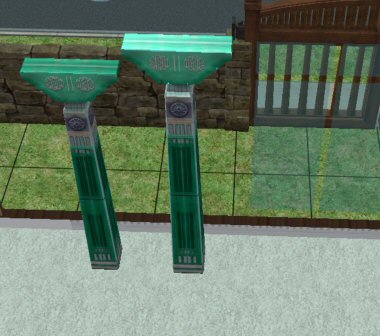- Site Map >
- Modding and Creation >
- Sims 2 Creation >
- Modding Discussion >
- Connecting a Slave Subset to a Repository Object
- Site Map >
- Modding and Creation >
- Sims 2 Creation >
- Modding Discussion >
- Connecting a Slave Subset to a Repository Object
Replies: 5 (Who?), Viewed: 3196 times.
#1
 29th Jan 2008 at 12:41 AM
29th Jan 2008 at 12:41 AM
In between my other current projects, I am undertaking the rather tedious process of resizing all the rest of the game's columns so that they actually fit. Most of these conversions were time consuming but easy, until I came to the base game's Central Asian column. I have been unable to have my newly resized Central Asian column retrieve its "columnLOD90" slave subset from the game's original. All the basic recolours work fine, but there is a curious lack of clarity and a dark inverted-V present at the top of my cloned column that is presumeably caused by the slave subset not linking properly. Note that this object also has a bump map in it, referenced within columncentralasian_column_blue_txmt.
In the attached picture, the original column is on the left and my newly resized one is on the right. I have also attached an archive containing the original in "reference" form (as described in IgnorantBliss's tutorial) as well as my current object. I have tried quite a few variations in both the Geometric Node and Shape modules, but with no luck so far. I suspect it is an easy fix, but I sure cannot find it! Any help would be appreciated.

Attached files:
| SDcolumncentralasian_reference.zip (96.4 KB, 16 downloads) - View custom content | ||||||||||||||
169326 01-28-08 07:26 SDcolumncentralasian_reference.package 102870 01-28-08 13:09 SDcolumncentralasian_medium1.package -------- ------- 272196 2 files |
||||||||||||||
Advertisement
#2
 30th Jan 2008 at 3:02 AM
30th Jan 2008 at 3:02 AM
From Jasana's tutorial I have found that the LOD90 module enables an object to be seen in the neighbourhood view. This is pretty much a necessity for a structural object, and no, my new column does not show up in the neighbourhood view either, whether or not I have LOD90's columnlod90_blue_txmt in my object.
#3
 31st Jan 2008 at 2:28 AM
Last edited by rebecah : 31st Jan 2008 at 2:44 AM.
31st Jan 2008 at 2:28 AM
Last edited by rebecah : 31st Jan 2008 at 2:44 AM.
I was playing around with you column some more. I haven't figure out how to pull the Lod90 portions but I did replace your mesh with the original just to see if that made a difference and I don't have the V. Either the textures aren't pulling right or the area of the mesh has some vertices moved.
Note in the photo that the gate I told you about even throws my door off. I didn't know that til I took the photo for you. lol

I also increased the mesh to 110% and still don't have the V. If you are using MilkShape for meshing be sure the auto smooth is unchecked.

Note in the photo that the gate I told you about even throws my door off. I didn't know that til I took the photo for you. lol
I also increased the mesh to 110% and still don't have the V. If you are using MilkShape for meshing be sure the auto smooth is unchecked.
#4
 31st Jan 2008 at 5:24 AM
31st Jan 2008 at 5:24 AM
Oh my goodness! I hate that Milkshape autosmooth, but yes, it was turned on! If I'm going to smooth I do it manually or within the mapper, but here I was going for absolute fidelity to the original. Thank you so much Rebecah! I will make sure I can replicate your results and then report back.
I just could not understand why the bump mapped secondary texture associated with the column subset could not be seen by the game engine, but that's the only explanation I could come up with for such a distortion after a simple upward relocation of the columns vertices (and hence its associated texture mapping). Its a great relief to know the answer to this one!
So now there is just the question of the LOD90 - and how the heck does the LOD90 in the original work when it does not reference any texture? My hope is that it automatically references the main texture in some way, but we shall see - hopefully.
I just could not understand why the bump mapped secondary texture associated with the column subset could not be seen by the game engine, but that's the only explanation I could come up with for such a distortion after a simple upward relocation of the columns vertices (and hence its associated texture mapping). Its a great relief to know the answer to this one!
So now there is just the question of the LOD90 - and how the heck does the LOD90 in the original work when it does not reference any texture? My hope is that it automatically references the main texture in some way, but we shall see - hopefully.
#5
 31st Jan 2008 at 6:40 AM
31st Jan 2008 at 6:40 AM
Posts: 612
Thanks: 33788 in 19 Posts
I suggest to read tutorial more carefully 
To show up in Neighborhood View, you need the GMDC-GMND-SHPE-CRES chain as well (Though I've read once that an object showed up even without it, it needs more investigation - I hadn't run into such Maxis object yet).
(Though I've read once that an object showed up even without it, it needs more investigation - I hadn't run into such Maxis object yet).
So, clone columnCentralAsianLOD90_cres by CRES name (when you switch to Workshop tab, instead of hitting Start - paste the name into 3rd editbox and hit 'Open by CRES-Name'), rename it to match your main column, and you'll have it in Neighborhood View.
And, by the way, columnLOD90 should not be listed in your SHPE, because it's not really a part of main version - it's part of neighborhood version, but it's pulled with the main - probably to ensure that recolors aren't messed up.
To show up in Neighborhood View, you need the GMDC-GMND-SHPE-CRES chain as well
 (Though I've read once that an object showed up even without it, it needs more investigation - I hadn't run into such Maxis object yet).
(Though I've read once that an object showed up even without it, it needs more investigation - I hadn't run into such Maxis object yet).So, clone columnCentralAsianLOD90_cres by CRES name (when you switch to Workshop tab, instead of hitting Start - paste the name into 3rd editbox and hit 'Open by CRES-Name'), rename it to match your main column, and you'll have it in Neighborhood View.
And, by the way, columnLOD90 should not be listed in your SHPE, because it's not really a part of main version - it's part of neighborhood version, but it's pulled with the main - probably to ensure that recolors aren't messed up.
#6
 1st Feb 2008 at 6:32 AM
Last edited by Sophie-David : 5th Feb 2008 at 4:22 AM.
Reason: New zip corrects problem with thumbnail
1st Feb 2008 at 6:32 AM
Last edited by Sophie-David : 5th Feb 2008 at 4:22 AM.
Reason: New zip corrects problem with thumbnail
Thank you Jasana, apart from your initial comment your reply was extremely helpful. Proceeding from your tip of Open by CRES-Name I now have whole new neighbourhood vistas before me! 
Having extracted columnCentralAsianLOD90_cres and saved it as SDcolumncentralasianLOD90_cres.package I then proceeded to merge its GMDC and GMND into the package of my custom size column. I set up the SHPE and GMND references to columnCentralAsianLOD90 in exactly the same way as I would for any other Maxis repository. I can report with a fair degree of certainty that LOD90 files are not compatible with the repository technique. No errors were produced, but my custom objects were simply not visible from the neighbourhood view.
However, merging the remainder of the LOD90 files into my custom package produced an object which was viewable from the neighbourhood, as expected. In the first picture below, the original sized Asian columns can be seen to alternate with my slightly taller custom sized ones.
My next step was to turn off Milkshape autosmooth and regenerate my column. Sure enough this eliminated the inverted V, however it became clear that the bump mapping was not occuring. In the second picture, it can be seen that the original shorter columns have a 3D effect that is missing in my taller ones.
Of course I assumed that the bump map was being ignored because the repository linkage was not able to retrieve the secondary bumped texture. After much experimentation I finally realized that it was the Milkshape OBJ import and export process that was wiping the bumped information. Instead one must export and import the GMDC using the Unimesh Milkshape plugins.
So the package is now working with both its primary and bump mapped secondary textures drawn from the Maxis original, as shown in the final picture.

Having extracted columnCentralAsianLOD90_cres and saved it as SDcolumncentralasianLOD90_cres.package I then proceeded to merge its GMDC and GMND into the package of my custom size column. I set up the SHPE and GMND references to columnCentralAsianLOD90 in exactly the same way as I would for any other Maxis repository. I can report with a fair degree of certainty that LOD90 files are not compatible with the repository technique. No errors were produced, but my custom objects were simply not visible from the neighbourhood view.
However, merging the remainder of the LOD90 files into my custom package produced an object which was viewable from the neighbourhood, as expected. In the first picture below, the original sized Asian columns can be seen to alternate with my slightly taller custom sized ones.
My next step was to turn off Milkshape autosmooth and regenerate my column. Sure enough this eliminated the inverted V, however it became clear that the bump mapping was not occuring. In the second picture, it can be seen that the original shorter columns have a 3D effect that is missing in my taller ones.
Of course I assumed that the bump map was being ignored because the repository linkage was not able to retrieve the secondary bumped texture. After much experimentation I finally realized that it was the Milkshape OBJ import and export process that was wiping the bumped information. Instead one must export and import the GMDC using the Unimesh Milkshape plugins.
So the package is now working with both its primary and bump mapped secondary textures drawn from the Maxis original, as shown in the final picture.
Attached files:
| SDcolumncentralasian_medium1.zip (36.2 KB, 15 downloads) - View custom content | ||||||||||
91730 02-02-08 20:00 SDcolumncentralasian_medium1.package
-------- -------
91730 1 file
|
||||||||||
Who Posted
|
|

 Sign in to Mod The Sims
Sign in to Mod The Sims